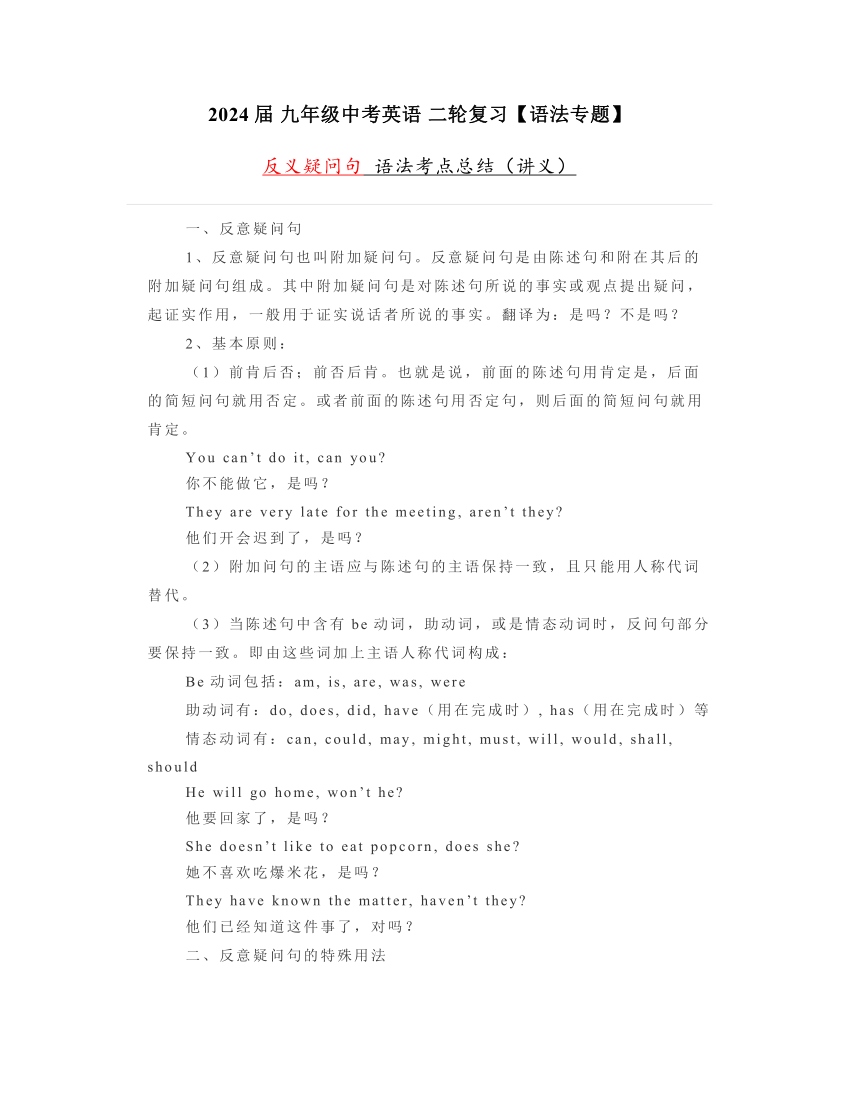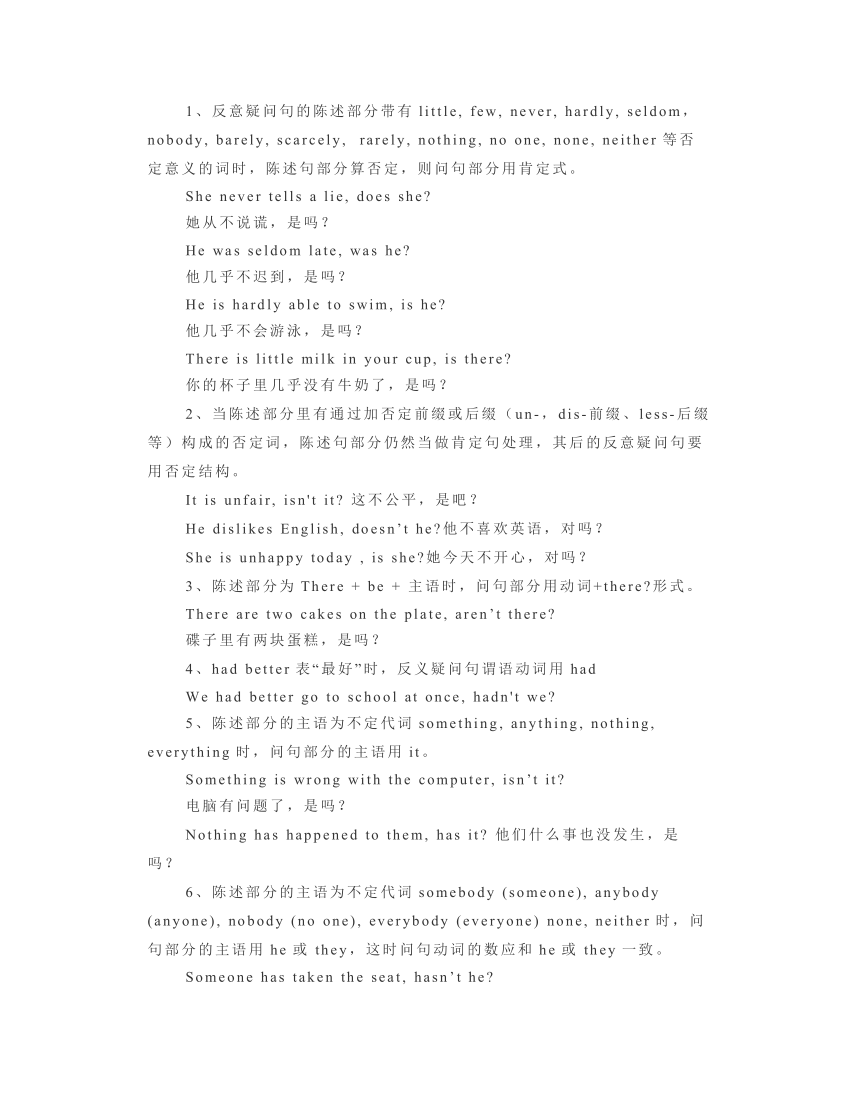反义疑问句 语法考点总结(讲义)2024届中考英语 二轮复习语法专题
文档属性
| 名称 | 反义疑问句 语法考点总结(讲义)2024届中考英语 二轮复习语法专题 |  | |
| 格式 | docx | ||
| 文件大小 | 20.3KB | ||
| 资源类型 | 教案 | ||
| 版本资源 | 通用版 | ||
| 科目 | 英语 | ||
| 更新时间 | 2023-10-23 11:10:30 | ||
图片预览


文档简介
2024届 九年级中考英语 二轮复习【语法专题】
反义疑问句 语法考点总结(讲义)
一、反意疑问句
1、反意疑问句也叫附加疑问句。反意疑问句是由陈述句和附在其后的附加疑问句组成。其中附加疑问句是对陈述句所说的事实或观点提出疑问,起证实作用,一般用于证实说话者所说的事实。翻译为:是吗?不是吗?
2、基本原则:
(1)前肯后否;前否后肯。也就是说,前面的陈述句用肯定是,后面的简短问句就用否定。或者前面的陈述句用否定句,则后面的简短问句就用肯定。
You can’t do it, can you
你不能做它,是吗?
They are very late for the meeting, aren’t they
他们开会迟到了,是吗?
(2)附加问句的主语应与陈述句的主语保持一致,且只能用人称代词替代。
(3)当陈述句中含有be动词,助动词,或是情态动词时,反问句部分要保持一致。即由这些词加上主语人称代词构成:
Be动词包括:am, is, are, was, were
助动词有:do, does, did, have(用在完成时), has(用在完成时)等
情态动词有:can, could, may, might, must, will, would, shall, should
He will go home, won’t he
他要回家了,是吗?
She doesn’t like to eat popcorn, does she
她不喜欢吃爆米花,是吗?
They have known the matter, haven’t they
他们已经知道这件事了,对吗?
二、反意疑问句的特殊用法
1、反意疑问句的陈述部分带有little, few, never, hardly, seldom,nobody, barely, scarcely, rarely, nothing, no one, none, neither等否定意义的词时,陈述句部分算否定,则问句部分用肯定式。
She never tells a lie, does she
她从不说谎,是吗?
He was seldom late, was he
他几乎不迟到,是吗?
He is hardly able to swim, is he
他几乎不会游泳,是吗?
There is little milk in your cup, is there
你的杯子里几乎没有牛奶了,是吗?
2、当陈述部分里有通过加否定前缀或后缀(un-,dis-前缀、less-后缀等)构成的否定词,陈述句部分仍然当做肯定句处理,其后的反意疑问句要用否定结构。
It is unfair, isn't it 这不公平,是吧?
He dislikes English, doesn’t he 他不喜欢英语,对吗?
She is unhappy today , is she 她今天不开心,对吗?
3、陈述部分为There + be + 主语时,问句部分用动词+there 形式。
There are two cakes on the plate, aren’t there
碟子里有两块蛋糕,是吗?
4、had better表“最好”时,反义疑问句谓语动词用had
We had better go to school at once, hadn't we
5、陈述部分的主语为不定代词something, anything, nothing, everything时,问句部分的主语用it。
Something is wrong with the computer, isn’t it
电脑有问题了,是吗?
Nothing has happened to them, has it 他们什么事也没发生,是吗?
6、陈述部分的主语为不定代词somebody (someone), anybody (anyone), nobody (no one), everybody (everyone) none, neither时,问句部分的主语用he或 they,这时问句动词的数应和he或 they一致。
Someone has taken the seat, hasn’t he
有人已经坐了位置,是吗?
Everyone has done their best in the game, haven’t they .
每个人在比赛中已经尽力了,是吗?
7、反意疑问句的陈述部分为I am……时,问句部分习惯上用aren’t I?
I am a very honest man, aren’t I
我是个很诚实的人,是吗?
8、陈述部分为祈使句
(1)若为let’s引导,反问句用shall we
Let’s go home together, shall we
让我们一起回家,好吗?
(2)若为let us/me引导 和否定祈使句,都用will you?
Let us stop to rest, will you
让我们停下休息,好吗?
Don’t make any noise, will you
别弄出噪音,好吗?
(3)肯定祈使句则用will you 或won’t you 都行。
Do sit down, won’t you / will you
请坐,好吗?
You feed the bird today, will you
今天你喂鸟,是吗?
Please open the window, will you (won’t you ) 打开窗,好吗?
9、陈述部分是主从复合句时,反义疑问句主语常与主句主语一致。
She said she would come tomorrow, didn’t she
10、但主句主语为第一人称I/We,谓语动词是think, believe, imagine, expect等时,从句是主要内容,反义疑问句主语常与从句主语一致,并注意否定前移。
I think he is a good student, isn’t he (从句是肯定句,所以反问部分用否定。)
We don’t think you are right, are you (否定转移,从句为否定,所以反问句部分用肯定。)
三、反意疑问句回答的特殊用法:
基本原则:
回答时,与事实相符合,是肯定的用Yes;完整回答就是:Yes,主语加部分谓语动词。
若与事实不符,是否定的则用No;完整回答就是:No,主语加部分谓语动词+not。
也就是说,回答前后保持一致,要肯定都肯定,要否定都否定,不能交叉使用。例如:不能说:yes, it isn’t. /No, it is.
1、当陈述部分为肯定式,反义疑问句为否定式时,其回答一般不会造成困难,一般只需照情况回答即可:
eg: "It’s new, isn’t it "
“Yes, it is." 是,是新的。”
“No,it isn't.”不,它不是新的。”
eg: “He wants to go, doesn’t he " "No, he doesn’t." “他想去,不是吗?”“不,他不想去。”
2、当陈述句部分为否定、附加疑问句部分为肯定这种句子,在回答中,yes /no和汉语意思正好相反。但是回答反意疑问句通常应根据实际情况来确定。
You aren’t a student, are you (你不是学生,对吗)
No, I’m not.(是的,我不是学生)而不能回答为Yes, I’m not.
Yes, I am.(不,我是学生)而不能回答为No,I am.
“It isn't a beautiful flower,is it?”
肯定会答“Yes,it is."不,它是一朵美丽的花。
否定为“No,it isn't."是的,它不是一朵美丽的花。
由上述例子可知,反义疑问句回答只需注意事实,肯定即用yes,否定用no,无需考虑句子原本是前否后肯或是前肯后否。(建议在答题时,先按照实际写后面的答句,再根据前后一致原则写Yes或No。)
综上所述,反义疑问句回答就是按实际情况回答。
反义疑问句 语法考点总结(讲义)
一、反意疑问句
1、反意疑问句也叫附加疑问句。反意疑问句是由陈述句和附在其后的附加疑问句组成。其中附加疑问句是对陈述句所说的事实或观点提出疑问,起证实作用,一般用于证实说话者所说的事实。翻译为:是吗?不是吗?
2、基本原则:
(1)前肯后否;前否后肯。也就是说,前面的陈述句用肯定是,后面的简短问句就用否定。或者前面的陈述句用否定句,则后面的简短问句就用肯定。
You can’t do it, can you
你不能做它,是吗?
They are very late for the meeting, aren’t they
他们开会迟到了,是吗?
(2)附加问句的主语应与陈述句的主语保持一致,且只能用人称代词替代。
(3)当陈述句中含有be动词,助动词,或是情态动词时,反问句部分要保持一致。即由这些词加上主语人称代词构成:
Be动词包括:am, is, are, was, were
助动词有:do, does, did, have(用在完成时), has(用在完成时)等
情态动词有:can, could, may, might, must, will, would, shall, should
He will go home, won’t he
他要回家了,是吗?
She doesn’t like to eat popcorn, does she
她不喜欢吃爆米花,是吗?
They have known the matter, haven’t they
他们已经知道这件事了,对吗?
二、反意疑问句的特殊用法
1、反意疑问句的陈述部分带有little, few, never, hardly, seldom,nobody, barely, scarcely, rarely, nothing, no one, none, neither等否定意义的词时,陈述句部分算否定,则问句部分用肯定式。
She never tells a lie, does she
她从不说谎,是吗?
He was seldom late, was he
他几乎不迟到,是吗?
He is hardly able to swim, is he
他几乎不会游泳,是吗?
There is little milk in your cup, is there
你的杯子里几乎没有牛奶了,是吗?
2、当陈述部分里有通过加否定前缀或后缀(un-,dis-前缀、less-后缀等)构成的否定词,陈述句部分仍然当做肯定句处理,其后的反意疑问句要用否定结构。
It is unfair, isn't it 这不公平,是吧?
He dislikes English, doesn’t he 他不喜欢英语,对吗?
She is unhappy today , is she 她今天不开心,对吗?
3、陈述部分为There + be + 主语时,问句部分用动词+there 形式。
There are two cakes on the plate, aren’t there
碟子里有两块蛋糕,是吗?
4、had better表“最好”时,反义疑问句谓语动词用had
We had better go to school at once, hadn't we
5、陈述部分的主语为不定代词something, anything, nothing, everything时,问句部分的主语用it。
Something is wrong with the computer, isn’t it
电脑有问题了,是吗?
Nothing has happened to them, has it 他们什么事也没发生,是吗?
6、陈述部分的主语为不定代词somebody (someone), anybody (anyone), nobody (no one), everybody (everyone) none, neither时,问句部分的主语用he或 they,这时问句动词的数应和he或 they一致。
Someone has taken the seat, hasn’t he
有人已经坐了位置,是吗?
Everyone has done their best in the game, haven’t they .
每个人在比赛中已经尽力了,是吗?
7、反意疑问句的陈述部分为I am……时,问句部分习惯上用aren’t I?
I am a very honest man, aren’t I
我是个很诚实的人,是吗?
8、陈述部分为祈使句
(1)若为let’s引导,反问句用shall we
Let’s go home together, shall we
让我们一起回家,好吗?
(2)若为let us/me引导 和否定祈使句,都用will you?
Let us stop to rest, will you
让我们停下休息,好吗?
Don’t make any noise, will you
别弄出噪音,好吗?
(3)肯定祈使句则用will you 或won’t you 都行。
Do sit down, won’t you / will you
请坐,好吗?
You feed the bird today, will you
今天你喂鸟,是吗?
Please open the window, will you (won’t you ) 打开窗,好吗?
9、陈述部分是主从复合句时,反义疑问句主语常与主句主语一致。
She said she would come tomorrow, didn’t she
10、但主句主语为第一人称I/We,谓语动词是think, believe, imagine, expect等时,从句是主要内容,反义疑问句主语常与从句主语一致,并注意否定前移。
I think he is a good student, isn’t he (从句是肯定句,所以反问部分用否定。)
We don’t think you are right, are you (否定转移,从句为否定,所以反问句部分用肯定。)
三、反意疑问句回答的特殊用法:
基本原则:
回答时,与事实相符合,是肯定的用Yes;完整回答就是:Yes,主语加部分谓语动词。
若与事实不符,是否定的则用No;完整回答就是:No,主语加部分谓语动词+not。
也就是说,回答前后保持一致,要肯定都肯定,要否定都否定,不能交叉使用。例如:不能说:yes, it isn’t. /No, it is.
1、当陈述部分为肯定式,反义疑问句为否定式时,其回答一般不会造成困难,一般只需照情况回答即可:
eg: "It’s new, isn’t it "
“Yes, it is." 是,是新的。”
“No,it isn't.”不,它不是新的。”
eg: “He wants to go, doesn’t he " "No, he doesn’t." “他想去,不是吗?”“不,他不想去。”
2、当陈述句部分为否定、附加疑问句部分为肯定这种句子,在回答中,yes /no和汉语意思正好相反。但是回答反意疑问句通常应根据实际情况来确定。
You aren’t a student, are you (你不是学生,对吗)
No, I’m not.(是的,我不是学生)而不能回答为Yes, I’m not.
Yes, I am.(不,我是学生)而不能回答为No,I am.
“It isn't a beautiful flower,is it?”
肯定会答“Yes,it is."不,它是一朵美丽的花。
否定为“No,it isn't."是的,它不是一朵美丽的花。
由上述例子可知,反义疑问句回答只需注意事实,肯定即用yes,否定用no,无需考虑句子原本是前否后肯或是前肯后否。(建议在答题时,先按照实际写后面的答句,再根据前后一致原则写Yes或No。)
综上所述,反义疑问句回答就是按实际情况回答。
同课章节目录
- 词法
- 名词
- 动词和动词短语
- 动词语态
- 动词时态
- 助动词和情态动词
- 非谓语动词
- 冠词
- 代词
- 数词和量词
- 形容词副词及其比较等级
- 介词和介词短语
- 连词和感叹词
- 构词法
- 相似、相近词比较
- 句法
- 陈述句
- 一般疑问句和否定疑问句
- 特殊疑问句及选择疑问句
- 反意疑问句
- 存在句(There be句型)
- 宾语从句
- 定语从句
- 状语从句
- 主谓一致问题
- 简单句
- 并列句
- 复合句
- 主谓一致
- 主、表语从句
- 名词性从句
- 直接引语和间接引语
- 虚拟语气
- 感叹句
- 强调句
- 倒装句
- 祈使句
- 句子的成分
- 句子的分类
- 题型专区
- 单项选择部分
- 易错题
- 完形填空
- 阅读理解
- 词汇练习
- 听说训练
- 句型转换
- 补全对话
- 短文改错
- 翻译
- 书面表达
- 任务型阅读
- 语法填空
- 其他资料
